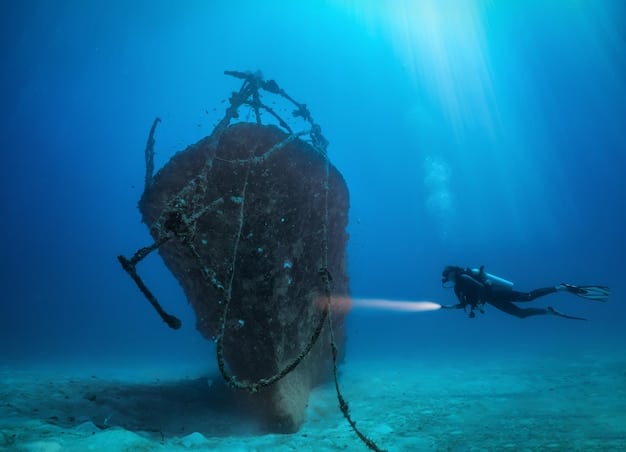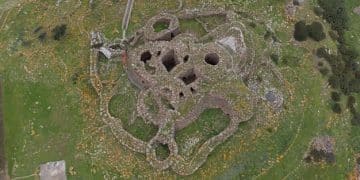US Underwater Archaeology: Discoveries & Heritage Laws 2025

Underwater archaeology in US waters is uncovering vital historical data through new discoveries, while federal and state laws, continually evolving, are crucial for protecting this submerged cultural heritage in 2025 against environmental threats and unauthorized recovery.
Delving into the hidden depths of American waters, Underwater Archaeology in US Waters: New Discoveries and the Laws Protecting Submerged Cultural Heritage in 2025 stands at the forefront of historical preservation and scientific exploration. This intricate field reveals profound insights into human history, from ancient shipwrecks to submerged civilizations, all while navigating a complex web of legal protections.
the evolving landscape of underwater archaeology in 2025
Underwater archaeology, an inherently interdisciplinary field, continues to push the boundaries of discovery and technological innovation. In 2025, the landscape is marked by an accelerating pace of new finds, driven by advanced sonar technologies, remotely operated vehicles (ROVs), and autonomous underwater vehicles (AUVs). These tools allow archaeologists to survey vast areas of the seafloor and penetrate challenging environments, revealing sites previously inaccessible.
The pursuit of submerged cultural heritage is not merely about finding artifacts; it’s about reconstructing narratives of human activity, migration, trade, and even climate change. From the Great Lakes to the Pacific and Atlantic coasts, and the Gulf of Mexico, American waters hold an estimated hundreds of thousands of shipwrecks, along with countless other submerged sites such as ancient settlements, indigenous fishing weirs, and even drowned landscapes that preserve evidence of prehistoric human habitation before sea levels rose. Each discovery adds a new chapter to our understanding of the past.
Technological advancements are profoundly shaping how archaeological survey and excavation are conducted. The precision offered by multibeam sonar mapping creates detailed three-dimensional models of wreck sites, dramatically improving initial assessments. Furthermore, advancements in sediment core sampling and genetic material analysis from submerged environments are providing unprecedented insights into ancient ecologies and human adaptation.
cutting-edge technology and methods
The tools and techniques available to underwater archaeologists are becoming increasingly sophisticated, enabling a more detailed and less intrusive exploration of submerged sites.
- Advanced Sonar Systems: Side-scan and multibeam sonar are crucial for initial surveys, creating high-resolution maps of the seafloor that reveal anomalies indicative of submerged structures or artifacts.
- ROVs and AUVs: These robotic platforms equip archaeologists with eyes and manipulators in deep or hazardous environments, reducing risks to human divers and extending survey capabilities.
- Photogrammetry and 3D Modeling: High-resolution cameras mounted on ROVs or by divers capture thousands of images, processed into detailed 3D models of sites, aiding in analysis and virtual preservation.
- Environmental Sensing: Sensors for temperature, salinity, and oxygen levels help assess preservation conditions and potential threats to sites.
These new methods are transforming the speed and scope of underwater archaeological projects, making it possible to systematically investigate larger areas and locate smaller, more subtle anomalies. The application of artificial intelligence and machine learning to analyze vast datasets collected from these surveys is also beginning to revolutionize how potential sites are identified and prioritized for further investigation.
The integration of big data analytics with traditional archaeological interpretation is leading to more comprehensive and nuanced understandings of past human interactions with marine environments. This holistic approach ensures that each discovery contributes meaningfully to the broader historical record, not just as isolated finds but as integral pieces of complex historical puzzles.
significant new discoveries in us waters (2025 outlook)
As 2025 approaches, the field of underwater archaeology in US waters continues to yield fascinating insights into our past. While specific groundbreaking finds forecasted for this year are speculative, current trends suggest a focus on several key areas. The increasing utilization of advanced technology by both academic institutions and government agencies is dramatically expanding the reach of exploration, leading to discoveries that challenge and refine our historical narratives.
One significant area of continued discovery involves shipwrecks from various historical periods. From early European colonial vessels to Civil War-era warships and 20th-century merchant ships, these submerged time capsules offer invaluable data on maritime trade, naval warfare, daily life at sea, and technological evolution. For example, recent years have seen renewed interest in locating and studying the ships lost during the Age of Sail in the Atlantic and Gulf of Mexico, as well as the numerous vessels that sank in the Great Lakes, some remarkably preserved by the cold, freshwater environments.
Beyond shipwrecks, archaeological attention is increasingly turning to submerged prehistoric landscapes. As ice sheets melted at the end of the last Ice Age, sea levels rose, inundating vast coastal plains and river valleys that were once home to early human populations. Discoveries in these areas, particularly off the coasts of Florida and the Gulf states, include evidence of ancient settlements, tools, and even human remains, providing direct insights into pre-Columbian life in North America.
notable recent finds and their impact
Recent archaeological endeavors have brought to light several key sites that illustrate the rich and diverse heritage lying beneath US waters. While predicting specific 2025 finds is challenging, historical patterns suggest breakthroughs in unique contexts.
- Deepwater Shipwrecks: Utilizing ROVs, archaeologists are accessing wrecks at depths previously unreachable, such as those from World War II, offering fresh perspectives on naval history and deep-sea preservation.
- Prehistoric Settlements: Discoveries off the Southeast coast, potentially extending from Florida to North Carolina, are revealing evidence of early human presence in areas now submerged, pushing back timelines of habitation.
- Indigenous Cultural Sites: Submerged sites in coastal and Great Lakes regions are yielding artifacts from indigenous cultures, providing critical information on their subsistence strategies, trade networks, and adaptation to changing environments.
- Civil War Era Vessels: Continuing investigations into Civil War shipwrecks, often found in rivers and coastal estuaries, shed light on the conflict’s naval strategies and the lives of those involved, offering a tangible link to a pivotal period in US history.
These discoveries are not just isolated artifacts; they are windows into past economies, societal structures, and environmental adaptations. The precise mapping and careful excavation of these sites, often in challenging underwater conditions, require extensive planning and multidisciplinary collaboration. Each find contributes to a broader tapestry of human history, enriching our understanding of how past communities interacted with their aquatic surroundings.
The academic and public impact of these discoveries is significant, fostering greater appreciation for underwater cultural heritage and reinforcing the importance of its preservation. Exhibitions, documentaries, and online resources born from these archaeological endeavors help connect a wider audience with the fascinating world beneath the waves, ensuring that these historical legacies are understood and valued by current and future generations.
federal laws protecting submerged cultural heritage
The protection of submerged cultural heritage in US waters is a complex legal tapestry woven from several key federal statutes. These laws aim to preserve historical and archaeological sites found beneath the waves, recognizing their immense value for research, education, and public enjoyment. The primary legislation governing these resources includes the Abandoned Shipwreck Act (ASA), the National Historic Preservation Act (NHPA), and various provisions related to federal lands and marine protected areas.
The Abandoned Shipwreck Act (ASA) of 1987 is perhaps the most significant piece of legislation for submerged cultural heritage. It asserts US government ownership over abandoned shipwrecks embedded in the submerged lands of the states and in US navigable waters. This act effectively removes abandoned shipwrecks from admiralty law, which typically grants salvage rights to finders, and places them under the jurisdiction of state governments to manage as public heritage. This shift was critical for protecting wrecks from commercial exploitation and promoting their archaeological study.
Beyond the ASA, the National Historic Preservation Act (NHPA) of 1966, as amended, plays a crucial role. Section 106 of NHPA requires federal agencies to consider the effects of their undertakings (such as dredging, construction, or permitting) on historic properties, including those that are submerged. This means that any federal project impacting US waters must undergo a review process to identify, evaluate, and mitigate adverse effects on archaeological sites, ensuring that potential heritage is not inadvertently destroyed.
key federal statutes and their implications
Understanding the nuances of federal laws is paramount for anyone involved in underwater exploration or development. These laws provide the framework within which archaeological work is conducted and sites are protected.
- Abandoned Shipwreck Act (ASA): Transfers ownership of abandoned shipwrecks on state submerged lands to the respective states (or to federal agencies for wrecks on federal lands), prioritizing preservation and public access over salvage.
- National Historic Preservation Act (NHPA): Mandates federal agencies to consider archaeological resources in their planning, requiring surveys and mitigation measures for federally funded or permitted projects that could impact submerged sites.
- Archaeological Resources Protection Act (ARPA): Protects archaeological resources (defined as any material remains of past human life or activities) on federal and tribal lands from unauthorized excavation, removal, or alteration, with significant penalties for violations.
- Sunken Military Craft Act (SMCA): Specifically protects military craft of the US and foreign nations, ensuring their status as sovereign property and prohibiting disturbance without permission, recognizing their historical and often revered nature as war graves.
These acts, along with others like the Outer Continental Shelf Lands Act (OCSLA) and various designations of marine sanctuaries and national parks, form a comprehensive, albeit sometimes complex, system for the management and protection of underwater cultural heritage. Compliance with these laws ensures that discoveries are handled ethically and scientifically, contributing to the public good rather than private gain.
The legal framework serves as a critical deterrent against looting and unauthorized disturbance, while promoting systematic archaeological investigation. Collaboration between federal agencies, state historic preservation offices, and academic institutions is essential for the effective implementation of these laws and the long-term stewardship of these irreplaceable historical assets.
state-level protections and partnerships
While federal laws provide a foundational layer of protection for submerged cultural heritage, state-level legislation and initiatives are equally vital, often offering more specific and localized protections. Each US state has the authority to manage the submerged lands within its territorial waters, typically extending three nautical miles from the coastline (with Texas and Florida having historical claims stretching to nine nautical miles in the Gulf of Mexico). This state jurisdiction complements federal laws, addressing the unique archaeological characteristics and historical contexts of their respective regions.
Many states have their own archaeological protection statutes that regulate the discovery, recovery, and preservation of underwater resources. These laws often establish permitting processes for archaeological investigations, prohibit unauthorized disturbance of sites, and outline protocols for reporting new discoveries. State Historic Preservation Offices (SHPOs) play a central role in implementing these regulations, serving as key points of contact for archaeologists, developers, and the public regarding submerged cultural resources within their borders.
Partnerships between state agencies, academic institutions, non-profit organizations, and even volunteer groups are crucial for effective stewardship. These collaborations facilitate research, fieldwork, and public outreach, ensuring that a broader range of expertise and resources are brought to bear on the challenges of underwater archaeology. For example, some states have established dedicated programs or task forces focused on maritime archaeology that work closely with local communities and diving clubs to foster an ethic of preservation.
how states manage and preserve their underwater heritage
States employ a variety of strategies to safeguard their aquatic historical treasures, often tailored to specific regional needs and available resources.
- State Archaeological Permits: Most states require permits for any archaeological work, including survey and excavation, on submerged lands under their jurisdiction, ensuring that activities meet professional archaeological standards.
- Designated State Parks and Preserves: Some states establish underwater archaeological preserves where significant sites are protected and often made accessible for recreational diving, promoting interpretation and public education.
- Educational and Outreach Programs: State historical societies and museums often develop programs that educate the public about underwater heritage, involving citizens in preservation efforts through citizen science initiatives or volunteer opportunities.
- Collaboration with Law Enforcement: States work with local and federal law enforcement to enforce anti-looting laws and prosecute individuals who illegally disturb or remove submerged cultural resources.
The success of these state-level programs often hinges on public awareness and engagement. By involving local communities and recreational divers in the identification and protection of sites, states can significantly enhance their ability to monitor and preserve submerged cultural heritage. The synergy between state and federal efforts creates a robust framework, ensuring that the historical riches beneath US waters are respected and conserved for future generations.
These localized efforts allow for a more nuanced approach to heritage management, recognizing that a shipwreck off the coast of Massachusetts might require different protective measures and research priorities than a submerged prehistoric site in Florida. This adaptability is key to the comprehensive preservation of the nation’s diverse underwater cultural legacy.
challenges and future outlook for 2025
Despite significant advancements in technology and legal frameworks, underwater archaeology in US waters faces persistent and evolving challenges. These obstacles range from the immense practical difficulties of working in submerged environments to the increasing threats posed by climate change and human activities. The outlook for 2025 emphasizes the need for continued innovation, stronger enforcement, and broader public engagement to address these issues effectively.
One of the foremost challenges is the sheer scale of the task. The vastness of US territorial waters and the estimated number of cultural sites within them mean that only a fraction can be thoroughly surveyed, let alone excavated. This requires strategic prioritization of sites based on their historical significance, research potential, and vulnerability to threats. Limited funding for archaeological research and preservation also remains a perennial concern, often forcing difficult choices in resource allocation.
Environmental factors pose a significant and growing threat. Sea-level rise, ocean acidification, increased storm intensity, and changes in bottom currents can directly impact submerged sites, accelerating decay or increasing exposure to damage. For example, stronger hurricanes can shift sands, burying or uncovering wrecks, sometimes exposing them to rapid deterioration or unauthorized salvaging. Marine construction, dredging, and offshore energy development also continue to threaten sites, necessitating careful environmental impact assessments and archaeological surveys.
overcoming hurdles and securing preservation
Meeting these challenges requires a multi-faceted approach, combining cutting-edge science with robust policy and public participation.
- Climate Change Adaptation: Developing strategies to monitor and mitigate the impacts of climate change on submerged sites, perhaps through protective measures like targeted sand placements or in situ stabilization.
- Enhanced Enforcement: Strengthening legal enforcement against looting and unauthorized salvage, including greater interagency cooperation and public awareness campaigns about the illegality and irreparable harm of such activities.
- Technological Innovation: Continued investment in and development of new non-intrusive survey methods, autonomous systems, and advanced data processing techniques to efficiently identify, document, and monitor sites.
- Public Awareness and Education: Fostering a greater public appreciation for underwater cultural heritage through educational programs, accessible digital content, and responsible tourism initiatives, transforming passive onlookers into active stewards.
The future of underwater archaeology in the US in 2025 will be defined by how effectively these challenges are met. Collaboration across federal, state, and local levels, combined with international partnerships on shared cultural heritage, will be crucial. Embracing technological advancements while maintaining ethical archaeological principles will ensure that future generations can continue to learn from and connect with the hidden histories beneath our waves.
The long-term preservation of these invaluable resources depends not only on scientific endeavor and legal protection but also on a collective societal commitment to valuing and safeguarding our shared past, ensuring they are understood as public trusts rather than commodities.
the role of technology in future discoveries
The trajectory of underwater archaeology in 2025 is inextricably linked to technological advances. The capacity to explore deeper, map more accurately, and analyze more comprehensively is continually expanding, promising to unlock new chapters of submerged history. These innovations aren’t just about finding more sites; they’re about enabling a less intrusive, more precise, and ultimately more sustainable approach to cultural heritage management.
One of the most transformative technologies is the continued evolution of autonomous underwater vehicles (AUVs). These uncrewed submersibles can cover vast areas of the seafloor autonomously, collecting high-resolution data with multibeam and side-scan sonar, magnetometers, and even sub-bottom profilers. Their ability to operate for extended periods and in conditions too hazardous for human divers dramatically increases the efficiency and scope of initial surveys, making the discovery of new sites more probable.
Beyond discovery, technology is revolutionizing documentation and analysis. Photogrammetry, a technique that uses multiple overlapping photographs to create precise 3D models, allows archaeologists to virtually reconstruct entire sites with millimeter accuracy. This provides an invaluable record for analysis, research, and public dissemination, even for sites that are too fragile or remote for frequent visits.
next-gen tools shaping underwater archaeology
The integration of advanced technological solutions is set to redefine the potential of underwater archaeological exploration and preservation.
- Enhanced AUV Capabilities: Future AUVs will be equipped with even more sophisticated sensors, including AI-driven anomaly detection, to identify potential archaeological sites with greater accuracy and less human intervention.
- Miniaturized Robotics and ROVs: Smaller, more agile robotic systems will allow for non-invasive exploration of tighter spaces within wreck interiors or complex geological formations, reducing the risk of disturbing delicate contexts.
- AI and Machine Learning: Algorithms will process vast datasets from sonar, photography, and environmental sensors, identifying patterns and potential sites that might be overlooked by human analysis, accelerating the discovery process.
- Advanced Sensor Technology: New generations of chemical and biological sensors can detect environmental changes or the presence of specific materials, helping assess the preservation state of artifacts or pinpoint organic remains.
These technological leaps are empowering archaeologists to move beyond mere identification to more detailed contextual analysis and better-informed preservation decisions. The ability to create ‘digital twins’ of submerged sites enables detailed study on land, minimizing the impact on fragile underwater environments. This virtual access also dramatically expands opportunities for public engagement, allowing anyone to explore a shipwreck or an ancient landscape from their computer or VR headset.
The horizon for underwater archaeology in 2025 promises a fusion of human expertise with robotic precision and analytical power, ensuring that the mysteries of our submerged past are continually unveiled with unprecedented detail and care. This technological evolution supports the mandate of preserving these irreplaceable cultural resources for future generations, transforming how we interact with historical landscapes beneath the waves.
public engagement and education in heritage preservation
The long-term preservation of submerged cultural heritage in US waters hinges significantly on public engagement and education. Laws and scientific endeavors alone are insufficient without a broad societal understanding of the value of these irreplaceable historical resources. In 2025, efforts to foster public awareness and participation are increasingly critical, turning passive audiences into active stewards of our underwater past.
Educational initiatives often target diverse groups, from schoolchildren to recreational divers and coastal communities. Programs about maritime history and underwater archaeology are incorporated into curricula, museum exhibits, and online platforms, making these fascinating subjects accessible. For recreational divers, specialized workshops and certification courses teach responsible diving practices around archaeological sites, emphasizing a ‘look, don’t touch’ ethic and the importance of reporting new finds to authorities rather than disturbing them.
Citizen science projects are also gaining traction, allowing lay citizens to contribute meaningfully to archaeological research. This might involve assisting with shoreline surveys for exposed artifacts, supporting data entry for historical records, or even participating in supervised underwater survey work. These programs not only expand the workforce available for archaeological tasks but also cultivate a sense of ownership and responsibility among participants, strengthening the advocacy for preservation.
fostering awareness and responsible stewardship
Engaging the public effectively in heritage preservation requires creative approaches that resonate with diverse interests and learning styles.
- Digital Outreach: Utilization of virtual reality, augmented reality, and high-resolution 3D models of submerged sites allows for immersive experiences, making remote sites accessible to everyone.
- Partnerships with Recreational Diving Communities: Collaborating with dive shops and clubs to promote ethical diving practices and provide training on how to identify and report archaeological features without disturbing them.
- Museum Exhibitions and Interpretive Centers: Developing engaging exhibits that showcase artifacts and stories from underwater discoveries, accompanied by interactive displays that explain archaeological processes and the importance of conservation.
- Community Volunteering Programs: Offering opportunities for citizens to participate in shoreline cleanups, artifact documentation, or educational events, fostering direct involvement with heritage protection.
By making underwater archaeology relatable and engaging, public education helps to demystify the field and highlight its relevance to contemporary society. This includes illustrating how past maritime activities shaped economies, cultures, and global interactions. A well-informed public is far more likely to support protective legislation, respect archaeological sites, and report suspicious activities.
Ultimately, comprehensive public engagement creates a virtuous cycle: increased awareness leads to greater appreciation, which in turn generates stronger political and financial support for the preservation of underwater cultural heritage. This collaborative stewardship ensures that the stories lying beneath the waves continue to inform and inspire generations to come, embodying the shared human story found in the depths.
| Key Point | Brief Description |
|---|---|
| 🔍 New Discoveries | Advanced tech (ROVs, AUVs, sonar) accelerating finds of shipwrecks and prehistoric sites. |
| ⚖️ Federal Laws | ASA, NHPA, ARPA, and SMCA protect sites, preventing unauthorized salvage and destruction. |
| 🗺️ State Protections | States manage territorial waters, issuing permits and partnering for site preservation. |
| Challenges Ahead | Climate change, funding, and looting necessitate innovative solutions and public support. |
frequently asked questions about underwater archaeology
▼
The primary goal of underwater archaeology is to study human history through material remains found in submerged environments. This involves the systematic discovery, documentation, excavation, and interpretation of sites like shipwrecks, submerged settlements, and artifacts, aiming to reconstruct past human behaviors, cultures, and interactions with aquatic landscapes while adhering to ethical preservation principles.
▼
The Abandoned Shipwreck Act (ASA) of 1987 asserts US government ownership over abandoned shipwrecks found in state and certain federal waters. It effectively removes these wrecks from traditional admiralty law, which grants salvage rights, and places them under the management of state governments as public heritage. This ensures their preservation for archaeological study and public enjoyment rather than commercial exploitation.
▼
Cutting-edge technologies like advanced multibeam and side-scan sonar systems provide high-resolution seafloor mapping. Remotely Operated Vehicles (ROVs) and Autonomous Underwater Vehicles (AUVs) enable safer and more extensive exploration of deep and hazardous sites. Photogrammetry and 3D modeling create precise virtual reconstructions, while AI and machine learning are increasingly used for data analysis and site identification, enhancing research efficiency.
▼
Yes, there are growing opportunities for public involvement. Many state and academic programs offer educational initiatives for recreational divers on responsible interaction with sites and reporting finds. Citizen science projects invite volunteers to assist with shoreline surveys or data processing. Museums and historical societies often host exhibits and lectures that promote public awareness and appreciation for submerged cultural heritage.
▼
Submerged cultural heritage faces several significant threats. Commercial salvaging and unauthorized looting remain major concerns, leading to site destruction and artifact removal. Environmental factors like climate change, sea-level rise, ocean acidification, and increased storm intensity can accelerate decay or damage sites. Additionally, marine construction, dredging, and offshore energy development pose risks of accidental destruction or disturbance to unknown sites.
conclusion
The field of underwater archaeology in US waters stands at a pivotal juncture in 2025, marked by accelerating discoveries, robust legal frameworks, and an increasing public appreciation for submerged cultural heritage. From ancient prehistoric landscapes to pivotal shipwrecks, these underwater sites offer unparalleled insights into human history. The diligent enforcement of federal and state laws, coupled with continuous technological innovation, is crucial for protecting these invaluable resources from environmental threats and illicit activities. As we look ahead, the synergy between expert archaeological endeavors, legal safeguards, and broad public engagement promises to deepen our understanding of the past and ensure that these submerged treasures are preserved for generations to come, revealing the captivating stories hidden beneath the waves.



